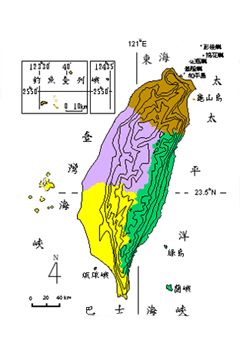The Social Geography of Taiwan

Relevant Websites
- She-hui-wen-ti-yan-jiu-tui-dong-wei-yuan-hui, Institute of Sociology, Academia Sinica
- Tai-wan-wen-hua-zi-xun-zhan
- Tai-wan-yan-yi
- Indigenous Peoples Commission, Taipei City Government
- Taiwan's History
Reference
- Wang, Jun-xiu, 1999: Huan-jing-nan-min-de-jie-ji-lun-shu, Huan-jing-xue-de- xiang-xiang, Tai-wan-she-hui-wen-ti-yan-jiu-yan-tao-hui, Institute of Sociology Academic Sinica
- Brown, L.R. (ED. AL.) 1993: State of the World 1993, New York: W.W. Norton & Company.
- Bryant, B. (ed.) 1995, Environmental Justice: Issue, Policies and Solutions, Washinton, D.C. : Island Press
- Chen, Chi-nan , 1987: Tai-wan-de-chuan-tong-zhong-guo-she-hui, Taipei, Linking Publishing Company, pp. 157-158.
- Li, Yih-yuan, 1992: Tai-wan-tu-zhu-min-zu-de-she-hui-yu-wen-hua, Forth Edition, Taipei, Linking Publishing Company, pp. 64-66.
- Wang, Fang, 1999: Min-yi-yu-jie-ceng-hua - Lao-jen-zheng-ce-zhi-she-hui-xue-shi-zheng-fen-xi, Tai-wan-she-hui-wen-ti-yan-jiu-yan-tao-hui, Institute of Sociology Academia Sinica.
- Ma, Shih-yuen, 1999: Tai-wan-yong-xu-fa-zhan-de-gun-jing-yu-chu-lu, Tai-wan-she-hui-wen-ti-yan-jiu-yan-tao-hui, Institute of Sociology Academia Sinica.
- Chen, Chi-nan, 1999: Zu-qun-gong-min-yu-di-fang-she-qu, China Times, Politics News.
Before the 17th century, Taiwan was a purely Austronesian society living in the Austronesian way. But after the 17th century, with the arrival of Han Chinese, conflicts arose, not only between the new immigrants and native Austronesians but also between different groups of immigrants and between old immigrants and new ones. However, as the island has faced new challenges under new leaders, the concept of individual origin has become much less important; instead, a new sense of community and of Taiwanese cultural identity has taken shape. After three hundred years, Taiwan is no longer a society of immigrants but a socially and culturally integrated island nation.
Before the 17th century: Austronesian society
Before the 1600s, as most of the residents in Taiwan were Austronesians, their lifestyle and the way their tribes were run very much decided the form of Taiwanese society. For example, in matriarchal tribes such as the Ami and Tsou where women played an important role, first daughters of families inherited the power and men could participate in public affairs only when old. On the contrary, in the Paiwan and Rukai tribes power was passed down to the oldest sons. Societies based on these blood relationships tended to be more self-contained and closed to the outside world.
Strict social stratification was another eminent feature of Austronesian society, which was based on a hierarchical ranking of chief, aristocracy and common people. Being chief was usually a hereditary position obtained by the oldest son. With its tight internal structure, the Rukai was a tribal society of this kind. All four of its classes─chief, aristocrats, fighters and common people─were hereditary positions that could be altered only through marriage.
After the 17th century: immigrant society
Beginning in the 16th century, many outsiders moved to Taiwan─they were the Dutch, Spanish, Japanese and Han Chinese. Especially after the surge of immigrants coming from southeastern China, the original Austronesian society gradually became a multi-cultural society consisting mainly of immigrants. Under the rule of the Ching Dynasty in the 18th century, more Chinese males came to Taiwan than females. Vigorous and adventurous as the society might appear, social problems arose: there were numerous secret cliques and complex relationships among different immigrant groups. Many single Chinese men married women from the local Pinpu tribe so that they could obtain land and settle down.
In this period, Han Chinese communities could be seen wherever trade and business were prosperous. Immigrants from the same village continued using the language and practicing the customs of their hometowns in China; they worshiped their ancestors on special occasions, and noted their origins on their graves. Immigrants evidently could not forget their native soil, and dreamed of going back one day either in their lifetime or in the afterlife.
To gain emotional support, Chinese immigrants developed clan organizations and set up religious activities through the temples. Their clan and religious activities were closely tied to where they came from. People of different origins got into frequent fights due to their different languages, ideas, and lifestyles as well as the fierce business competition.
Localized society taking shape
As time went by, a new sense of community and of Taiwanese cultural identity took shape. Immigrants tended to identify themselves with this island instead of with their hometown on the mainland. They referred to themselves as "northern Taiwanese" or "southern Taiwanese" rather than as people from certain Chinese towns such as Tangshan, Changchou or Chuanchow.
Even their ideas about blood relationships and religion changed. They no longer insisted on going back to their Chinese hometowns but recognized Taiwan as their new home. Many of their deities, like Koxinga and Matsu, were renamed as "the first god/goddess to explore Taiwan." This reflected not only the adventurous character of Taiwanese but also a new society that increasingly regarded itself as independent from China.
"Localization" was quite obvious at the end of the 19th century. In 1895 when the Ma-guan treaty ceded Taiwan to Japan, the Taiwanese were given a choice of nationality and place of residence. Two years later, only 6,456 left the island. Most people decided to stay and fought against the Japanese regime with organizations and activities in the name of Taiwan.
Multi-cultural modern society
The latest group of immigrants arrived in Taiwan around 1949 to escape the Chinese communists. After fifty years, they have become integrated into Taiwanese society. Since the 1990s, the common goal of all the island's residents has been to continue building and developing a unified Taiwanese community. Like many other highly developed countries, Taiwan's industrialized and urbanized society not only enjoys a robust economy and rich educational and cultural opportunities; it also is becoming increasingly open to new and various ideas, attitudes and values. As the feeling of difference among ethnic groups diminishes a culturally integrated society is emerging, one with legalized welfare for all and a foundational sense of community.